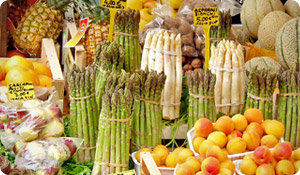
Fresh fruits and vegetables are nutritional powerhouses, packed with vitamins and minerals that are essential to good health, as well as phytochemicals and antioxidants that help fight chronic disease. How fresh produce is handled between when it is harvested and when it actually reaches your kitchen, has a great impact on how many of those important nutrients actually end up on your plate. Here's how to choose and use fresh fruits and vegetables to get the most nutrition and the best flavor possible.
- Eat deeply colored vegetables. Dark green, orange and red flesh and leaves are obvious signs of good nutrition. Choose the most colorful vegetables-broccoli, spinach and other leafy greens, carrots, peppers, butternut and other types of winter squash-and you know you're getting maximum nutrition for your money.
- Stay small. Bigger is not always better, especially in the plant kingdom. For the best flavor and highest concentration of nutrients, fruits and vegetables need to grow to maturity but not to jumbo size. Oversized produce may be past its prime.
- Eat sustainably. Though there may be other good reasons for choosing organic foods, most studies conclude that there is no significant difference in the nutritional value between organic and conventionally grown fruits and vegetables. Sustainably-grown fruits and vegetables, which are those that may be grown with synthetic fertilizers but few to no chemical pesticides, offer the health benefits of essential nutrients without the risk of harmful chemicals ending up in the soil,the food or your body.
- Don't peel. Many nutrients are concentrated close to the surface of fruits and vegetables, so whenever possible, leave the skin on. This is another good reason to choose organic produce but regardless, be sure to wash fresh fruits and vegetables carefully before cooking and eating.
- Cook healthily. Steaming, stir-frying, microwaving, broiling and high-temperature roasting are all quick cooking methods that preserve both flavor and nutrients in vegetables. For some vegetables, such as carrots and tomatoes, cooking is better than raw because heat breaks down the vegetable's cell walls, making vitamins and phytochemicals more easily available for absorption by the body.
- Eat locally. Take advantage of farmer's markets and look for locally grown produce in your supermarket. The more time fruits and vegetables have to ripen naturally and the less time they spend traveling, the fresher and more nutritious they're likely to be.
- Use it up. Stored produce loses nutrients, so try to use up produce soon after purchase. For the same reason, leave fresh produce whole until you are ready to cook or eat them.
Sources:
Barrett, D. "Maximizing the Nutritional Value of Fruits and Vegetables." University of California Davis Post-Harvest Technology Research & Information Center. Web. 27 Aug 2010.
http://postharvest.ucdavis.edu/datastorefiles/234-780.pdf
Dangour, A et al. "Nutritional Quality of Organic Foods: A Systematic Review." American Journal of Clinical Nutrition. (90) 680-685 29 Jul 2009. Web. 27 Aug 2010.
http://www.ajcn.org/cgi/content/abstract/90/3/680
Garden-Robinson, J. "What Color is Your Food?" North Dakota State University Extension. Feb 2009. Web 27 Aug 2010.
http://www.ag.ndsu.edu/pubs/yf/foods/fn595w.htm#nutrients
Harvard Meical School Center for Health and The Global Environment. "Healthy and Sustainable Food." 2010. Web. 27 Aug 2010.
http://chge.med.harvard.edu/programs/food/local.html
http://chge.med.harvard.edu/programs/food/nutrition.html





